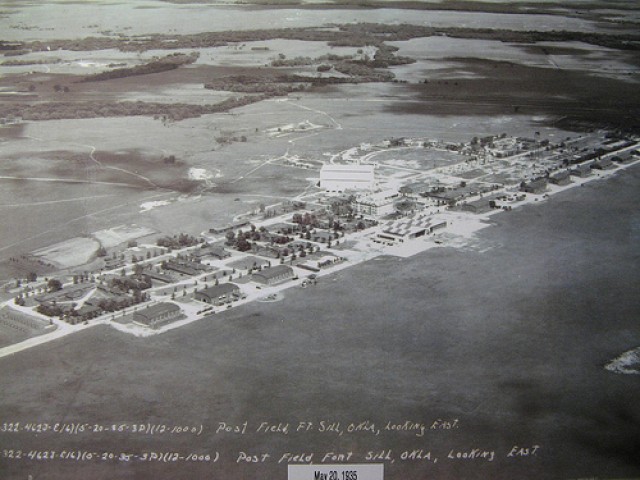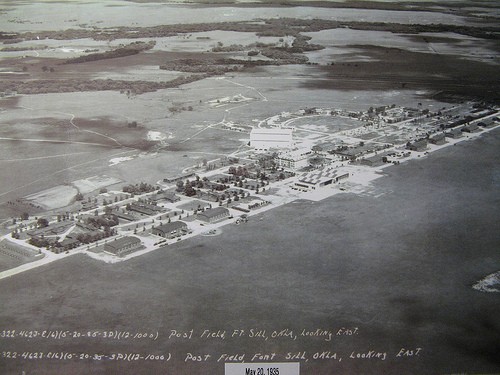
Fort Rucker, Ala.' Dayton, Ohio' Did you know it was Fort Sill, Okla.'
Henry Post Army Airfield at Fort Sill is named in memory of Lt. Henry B. Post, a pioneer military aviator, who was killed in an airplane accident near San Diego, Calif., in 1914 while attempting to set an altitude record.
In 1915, the first air unit in the U.S. military service, the 1st Aero Squadron, commanded by Capt. (later Maj. Gen.) Benjamin D. Foulois, was stationed at Fort Sill for experiments in the aerial observation of artillery fire.
Fort Sill was the first tactical station for this unit. While here, the squadron made the first aerial mosaic, or aerial photograph, using a Brock automatic camera.
The first squadron cross-country flight of the Air Service began at Fort Sill when six Curtiss "Jennies" of the 1st Aero Squadron flew from Fort Sill to Fort Sam Houston, Texas, a distance of 439 miles.
On March 15, 1916, while still assigned to Fort Sill, this squadron became the first U.S. air unit to go combat ready in the field when it began operations with Gen. Blackjack Pershing's expedition into Mexico.
The school for aerial observers, flying balloons and fixed-wing craft, was established at Henry Post Field in 1918. By 1922, it was estimated that more miles were flown at Fort Sill than at any other field in the United States. During the next two decades, many squadrons, equipped with a variety of aircraft, were based and trained here. In 1942, Air Corps facilities at Post Field were turned over to Army Aviation.
Birth of Army air
On June 6, 1942, as a result of the "Class Before One" experiment, the War Department established Army Aviation at Fort Sill. The Department of Air Training, directed by Lt. Col. (later Brig. Gen.) William W. Ford, received 19 students for Class One Aug. 1, 1942.
On Nov. 9, 1942, Army Aviation entered combat when an L-4 flew from the USS Ranger during the invasion of North Africa. Army Aviation was so successful in World War II, that in August 1945 it was made organic to all combat branches of the Army.
Until 1946, when the first concrete runway was poured, students landed on the grass near the hangars.
The increased demand of Army Aviation by all arms and services so rapidly increased the volume of training that on June 6, 1953, the Department of Air Training was deactivated and the U.S. Army Aviation School was established at Fort Sill.
The continued growth and worldwide support by Army Aviation caused it to outgrow its birthplace and in August 1954, the Army Aviation School moved to Fort Rucker, Ala.
Army Aviation has a new home, but Fort Sill has never wavered in its support. In the intervening years, Fort Sill has been the home of many Army Aviation units, particularly, those of medium and heavy lift capability and has made many contributions to Army Aviation's expansion from the "Grasshopper" to the Airmobile Division.
Current operations
The Airfield Operations Division at Fort Sill is an organization that works to support today's units and Soldiers. Henry Post Army Airfield has the proven capability of deploying Fort Sill's combat assets using C-17 Globemaster III and C-130 Hercules aircraft. In the past five years, airfield operations has supported the mobilizing of three National Guard combat aviation brigades and numerous medical, medium and heavy lift helicopter and fixed wing battalions.
The Airfield Operations Division works diligently to provide excellent customer service and superior aviation support. They also provide important airfield facilities and services for joint training with other services and allies.
Military units and commanders may request eight- to 90-passenger operational support aircraft to support their unit's missions and training at no cost by submitting requests for MILAIR to the airfield operation officer in Building 4907 on Post Road or by calling 442-6160. ]
The Airfield Operations Division coordinates all airfield operations and infrastructure maintenance activities to support a safe operating environment. Furthermore, they ensure statutory and regulatory compliance with Army, Installation Management Command and Federal Aviation Administration regulations and they coordinate with the Army Aeronautical Services Agency and Army Air Traffic Control Activity. They also provide flight management services to aircrews.

Social Sharing